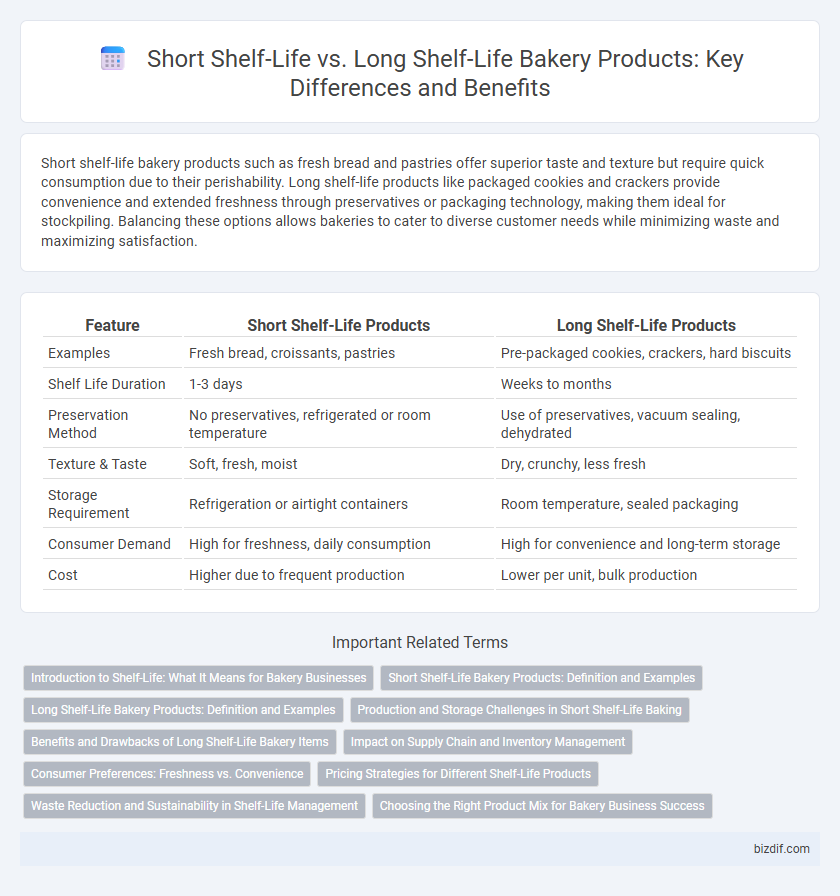Short shelf-life bakery products such as fresh bread and pastries offer superior taste and texture but require quick consumption due to their perishability. Long shelf-life products like packaged cookies and crackers provide convenience and extended freshness through preservatives or packaging technology, making them ideal for stockpiling. Balancing these options allows bakeries to cater to diverse customer needs while minimizing waste and maximizing satisfaction.
Table of Comparison
| Feature | Short Shelf-Life Products | Long Shelf-Life Products |
|---|---|---|
| Examples | Fresh bread, croissants, pastries | Pre-packaged cookies, crackers, hard biscuits |
| Shelf Life Duration | 1-3 days | Weeks to months |
| Preservation Method | No preservatives, refrigerated or room temperature | Use of preservatives, vacuum sealing, dehydrated |
| Texture & Taste | Soft, fresh, moist | Dry, crunchy, less fresh |
| Storage Requirement | Refrigeration or airtight containers | Room temperature, sealed packaging |
| Consumer Demand | High for freshness, daily consumption | High for convenience and long-term storage |
| Cost | Higher due to frequent production | Lower per unit, bulk production |
Introduction to Shelf-Life: What It Means for Bakery Businesses
Shelf-life defines the duration bakery products maintain safety, freshness, and flavor, directly impacting inventory management and waste reduction. Short shelf-life items like fresh bread require rapid turnover and precise demand forecasting to minimize spoilage and maximize customer satisfaction. Long shelf-life baked goods, such as packaged cookies or crackers, offer extended market reach and flexible distribution but often involve preservatives that influence product formulation and labeling.
Short Shelf-Life Bakery Products: Definition and Examples
Short shelf-life bakery products refer to baked goods that remain fresh and safe for consumption only within a few hours to days after production due to high moisture content and lack of preservatives. Common examples include fresh bread, croissants, pastries, and cakes, which require refrigeration or immediate sale to maintain quality. These products are prone to spoilage and microbial growth, demanding careful handling and swift turnover in bakery operations.
Long Shelf-Life Bakery Products: Definition and Examples
Long shelf-life bakery products are baked goods formulated or processed to extend freshness and prevent spoilage over extended periods, often through preservatives, modified atmosphere packaging, or dehydration techniques. Examples include packaged biscuits, hard breads like rusks, and certain types of cakes such as fruitcakes, which retain quality for weeks or months. These products offer convenience for distribution and storage, reducing waste and ensuring availability beyond the typical freshness window of perishable bakery items.
Production and Storage Challenges in Short Shelf-Life Baking
Short shelf-life bakery products face intense production and storage challenges due to their high moisture content, requiring precise temperature control and rapid distribution to maintain freshness and prevent microbial growth. In contrast, long shelf-life products often incorporate preservatives and modified packaging technologies to extend usability but may compromise texture and flavor. Efficient inventory management and cold storage systems are critical in minimizing spoilage and waste for short shelf-life baked goods.
Benefits and Drawbacks of Long Shelf-Life Bakery Items
Long shelf-life bakery items reduce food waste and improve supply chain efficiency by remaining fresh for weeks or months without refrigeration. These products often contain preservatives or undergo processes like freezing, which may impact texture and flavor compared to fresh bakery goods. While convenient for inventory management and extended distribution, long shelf-life items can sacrifice the artisan quality and taste that fresh bakery products offer.
Impact on Supply Chain and Inventory Management
Short shelf-life bakery products demand frequent restocking and rapid turnover, increasing complexity in supply chain coordination and inventory management to minimize waste and ensure freshness. Long shelf-life bakery items allow for bulk purchasing and extended storage, reducing frequency of deliveries and enabling more predictable inventory control. Efficient balancing between these product types optimizes supply chain responsiveness and reduces costs related to spoilage and stockouts.
Consumer Preferences: Freshness vs. Convenience
Consumers often prefer short shelf-life bakery products like fresh bread and pastries for their superior taste and texture, which align with a desire for freshness and quality. Long shelf-life products such as packaged cookies and pre-sliced bread appeal primarily to convenience-minded buyers prioritizing extended usability and reduced waste. Understanding these preferences helps bakeries tailor their offerings to different market segments, balancing freshness with practical consumption needs.
Pricing Strategies for Different Shelf-Life Products
Pricing strategies for bakery products with short shelf-life, such as fresh bread and pastries, often involve premium pricing to reflect freshness and high demand within limited timeframes. Long shelf-life products like packaged cookies or dry cakes leverage competitive pricing and bulk sales to attract cost-conscious consumers and reduce inventory risk. Dynamic pricing models and promotional discounts are commonly used to balance inventory turnover and minimize waste across both product categories.
Waste Reduction and Sustainability in Shelf-Life Management
Short shelf-life bakery products like fresh bread and pastries demand precise inventory control to minimize waste and optimize freshness, directly supporting sustainability goals by reducing landfill contributions. Long shelf-life items such as packaged cookies and dry mixes enable extended stock rotation, lowering spoilage rates and enhancing waste reduction efforts through better demand forecasting. Effective shelf-life management combines accurate expiration monitoring with adaptive production scheduling to balance freshness with sustainability in bakery operations.
Choosing the Right Product Mix for Bakery Business Success
Selecting the ideal product mix between short shelf-life items like fresh bread and pastries, and long shelf-life goods such as packaged cookies and crackers, directly impacts bakery profitability and customer satisfaction. Short shelf-life products demand precise inventory management to minimize waste and ensure peak freshness, while long shelf-life products provide steady sales and extended market reach. Balancing these product types optimizes turnover, reduces spoilage costs, and meets diverse consumer preferences for sustained bakery business growth.
Short shelf-life products vs Long shelf-life products Infographic

 bizdif.com
bizdif.com